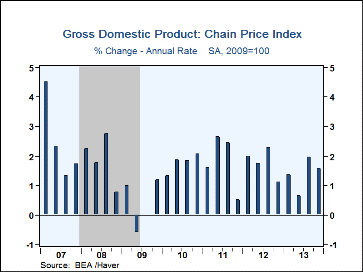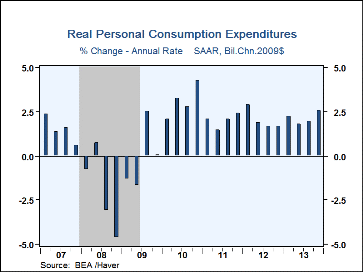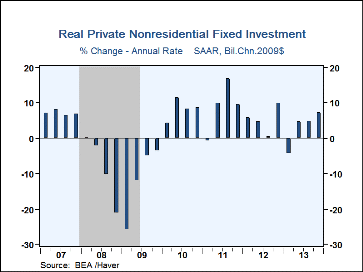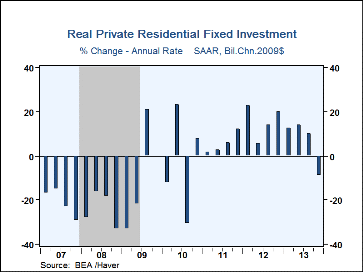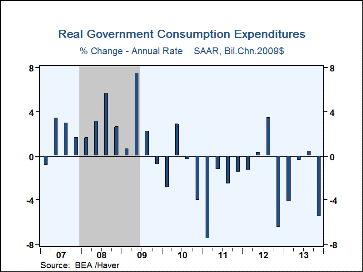 Global| Feb 28 2014
Global| Feb 28 2014U.S. GDP Growth is Revised Lower; Price Inflation Raised
by:Tom Moeller
|in:Economy in Brief
Summary
Real GDP growth for Q4'13 eased more than initially estimated. The growth estimate was lowered by the Department of Commerce to 2.4% (2.5% y/y) from 3.2% in the advance release, down sharply from 4.1% in the third quarter. The gain [...]
Real GDP growth for Q4'13 eased more than initially estimated. The growth estimate was lowered by the Department of Commerce to 2.4% (2.5% y/y) from 3.2% in the advance release, down sharply from 4.1% in the third quarter. The gain roughly matched consensus expectations for a 2.5% rise in the Action Economics Forecast Survey. For all of last year growth moderated to 1.9%, down nearly a full percentage point from 2012.
Domestic final sales rose at a lessened 1.2% rate (1.5% y/y) last quarter. Growth in personal consumption expenditures was lowered to 2.6% (2.1% y/y). Spending growth on durable goods eased sharply to 2.5% (5.6% y/y) as motor vehicle purchases slipped (+2.1% y/y). Spending on home furnishings & appliances rose at a 2.4% rate (7.1% y/y), the weakest gain since Q2 2012. Nondurable spending, however, jumped at a 3.5% rate (2.7% y/y) led by a surge in purchases of apparel. Growth in spending on services still improved sharply to 2.2% (1.4% y/y). To the upside, business fixed investment growth was nearly doubled to 7.3% (3.0% y/y). Residential investment showed a lessened 8.8% decline (+6.6% y/y) but spending still jumped 12.1% for all of 2013. The decline in government spending was deepened to 5.5% (-2.5% y/y). The fall subtracted roughly a full percentage point from Q4 GDP growth. Defense spending fell at a 14.5% rate (-6.9% y/y) while state & local government spending growth eased 0.5% (+0.1% y/y). Final sales to private domestic purchasers grew at a 2.8% rate (2.4% y/y), little changed from the advance estimate.
The effects from inventory investment and foreign trade were lessened but remained positive. A faster rate of inventory accumulation added 0.1 percentage point to Q4 GDP growth following the 1.7 point addition in Q3. A lessened foreign trade deficit added one percentage point to Q4 growth. The improvement owed last quarter to a 9.4% rise (4.9% y/y) in exports versus a 1.5% gain (2.8% y/y) in imports.
Price inflation moderated in Q4, though not as much as initially estimated. The chain-type GDP price index rose at a 1.6% rate (1.4% y/y) versus the advance estimate of a 1.3% increase and a 2.0% Q3 gain. A 1.3% rise had been expected. The personal consumption price index rose at a 1.0% rate (1.0% y/y) while the business fixed investment price index increase held q/q at 1.2% (1.2% y/y). The residential investment price index surged at an 8.2% rate (6.2% y/y), the fastest y/y growth since early 2006.
The latest GDP figures can be found in Haver's USECON and USNA databases; USNA contains basically all of the Bureau of Economic Analysis' detail in the national accounts, including the new integrated economics accounts and the recently added GDP data for U.S. Territories. The Action Economics consensus estimates can be found in AS1REPNA.
| Chained 2009 $, %, AR | Q4'13 (2nd Estimate) | Q4'13 (Advance) | Q3'13 | Q2'13 | Q4 Y/Y | 2013 | 2012 | 2011 |
|---|---|---|---|---|---|---|---|---|
| Gross Domestic Product | 2.4 | 3.2 | 4.1 | 2.5 | 2.5 | 1.9 | 2.8 | 1.8 |
| Inventory Effect | 0.1 | 0.4 | 1.7 | 0.4 | 0.2 | 0.2 | 0.2 | -0.2 |
| Final Sales | 2.3 | 2.8 | 2.5 | 2.1 | 1.7 | 1.7 | 2.6 | 2.0 |
| Foreign Trade Effect | 1.0 | 1.3 | 0.1 | -0.1 | 0.2 | 0.2 | 0.2 | 0.2 |
| Domestic Final Sales | 1.2 | 1.4 | 2.3 | 2.1 | 1.5 | 1.5 | 2.4 | 1.8 |
| Demand Components | ||||||||
| Personal Consumption | 2.6 | 3.3 | 2.0 | 1.8 | 2.1 | 2.0 | 2.2 | 2.5 |
| Business Fixed Investment | 7.3 | 3.8 | 4.8 | 4.7 | 3.0 | 2.8 | 7.3 | 7.6 |
| Residential Investment | -8.8 | -9.8 | 10.3 | 14.2 | 6.6 | 12.1 | 12.9 | 0.5 |
| Government Spending | -5.5 | -4.9 | 0.4 | -0.4 | -2.5 | -2.3 | -1.0 | -3.2 |
| Chain-Type Price Index | ||||||||
| GDP | 1.6 | 1.3 | 2.0 | 0.6 | 1.4 | 1.4 | 1.7 | 2.0 |
| Personal Consumption | 1.0 | 0.7 | 1.9 | -0.1 | 1.0 | 1.1 | 1.8 | 2.4 |
| Less Food/Energy | 1.3 | 1.1 | 1.4 | 0.6 | 1.2 | 1.2 | 1.8 | 1.4 |
Tom Moeller
AuthorMore in Author Profile »Prior to joining Haver Analytics in 2000, Mr. Moeller worked as the Economist at Chancellor Capital Management from 1985 to 1999. There, he developed comprehensive economic forecasts and interpreted economic data for equity and fixed income portfolio managers. Also at Chancellor, Mr. Moeller worked as an equity analyst and was responsible for researching and rating companies in the economically sensitive automobile and housing industries for investment in Chancellor’s equity portfolio. Prior to joining Chancellor, Mr. Moeller was an Economist at Citibank from 1979 to 1984. He also analyzed pricing behavior in the metals industry for the Council on Wage and Price Stability in Washington, D.C. In 1999, Mr. Moeller received the award for most accurate forecast from the Forecasters' Club of New York. From 1990 to 1992 he was President of the New York Association for Business Economists. Mr. Moeller earned an M.B.A. in Finance from Fordham University, where he graduated in 1987. He holds a Bachelor of Arts in Economics from George Washington University.



